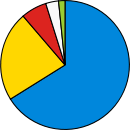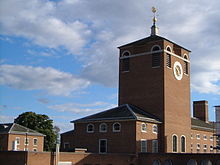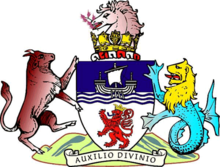- Devon County Council
-
Devon County Council 
Type Type Unicameral of county council Leadership Leader of the cabinet John Hart, Conservative
since 25 June 2009Structure Members 62 
Political groups Conservative Party
Liberal Democrats
Labour Party
Independents
Green PartyElections Voting system First past the post Last election 4 June 2009 Meeting place 
County Hall, Exeter Website www.devon.gov.uk Devon County Council is the county council administering the English county of Devon. Based in the city of Exeter, the council covers the non-metropolitan county area of Devon. Members of the council (councillors) are elected every four years to represent the electorate of each county division, almost all being nominated by the major national political parties.
The population of the area administered by the council is estimated at 754,700, making it the largest local authority in South West England.
Devon is an area with "two-tier" local government, meaning that the county is divided into non-metropolitan districts carrying out less strategic functions, such as taking most planning decisions. In Devon there are eight such districts, each with its own district, borough, or city council.
Contents
History
Administration
Before 1888, the small towns and rural areas in Devon were governed by magistrates through the Devon Court of Quarter Sessions. The magistrates were based at Rougemont Castle, Exeter, and were not elected by the people. In 1888, the Local Government Act 1888 was passed, which paved the way for democracy at the county level throughout England and Wales. On 16 January 1889, the first County Council elections were held, and the council began life with a budget of £50,000. In 1907, women became eligible for election and the first female councillor was elected in 1931.[1] From the beginning in 1889, the county boroughs of Exeter, Devonport and Plymouth were outside the jurisdiction of the county council. Devonport was afterwards absorbed by the City of Plymouth. Torbay received county borough status and left the area of Devon County Council in 1968.
County Hall
At first, meetings were held in a courtroom in Rougemont Castle until County Hall was built.[1] County Hall is situated in Topsham Road, about 1 mile (1.6 km) south-east of Exeter city centre, in the grounds of Bellair House, rebuilt around 1700 by the merchant John Vowler, and the adjoining early Victorian house, Coaver.[2] The houses are now incorporated in the council's campus; Coaver houses the main social club.[3] Construction began on County Hall in 1954; it was designed by Donald McMorran and was finished in 1964.[3] Extensions were completed in 1984.[2] In 1998 the buildings gained Grade II* status.[3]
Political composition
In Devon, most county councillors who are elected have been nominated by one of England's major political parties, although there are also a small number of independents. At present well over half of the councillors in the chamber are Conservatives, who hold 41 of the 62 seats. The council currently operates the local government Cabinet system which was introduced by the Local Government Act 2000, with the Leader of the Cabinet (and effective head of the authority) elected by the full council. In practice, the Leader is chosen from among the majority Conservative group. After being elected, the Leader chooses the other cabinet members, currently nine, all from the Conservative group.
The Liberal Democrats have the second highest number of councillors, with fourteen, while there are four Labour members, all representing county divisions in Exeter. There are two independent members, and the Green Party has one councillor.
Devon County Council election, 2009[4][5] Party Seats Gains Losses Net gain/loss Seats % Votes % Votes +/- Conservative 41 +18 66.1 41.9 106,411 Liberal Democrat 14 -19 22.6 29.9 75,815 Labour 4 0 6.5 6.1 15,339 Independent 2 0 3.2 4.6 11,768 Green 1 1 0 +1 1.6 6.8 17,290 Responsibilities for services
 Map of Devon's eight shire districts and two unitary authorities. 1-8 are administered by Devon County Council, but 9 and 10 are the unitary authority areas of Plymouth and Torbay, which are self-governed on local issues; they are considered part of the ceremonial county of Devon
Map of Devon's eight shire districts and two unitary authorities. 1-8 are administered by Devon County Council, but 9 and 10 are the unitary authority areas of Plymouth and Torbay, which are self-governed on local issues; they are considered part of the ceremonial county of Devon
Devon County Council's responsibilities include schools, social care for the elderly and vulnerable, road maintenance, libraries and trading standards.[6] The Office for National Statistics estimated that the mid-2008 population of the non-metropolitan area of Devon was 754,700, which is the largest in the South West England region.[7] It is the largest employer in Devon, employing over 20,000 people.[6]
The county council's area is also administered by eight smaller authorities that have their own district, borough or city councils. The responsibilities of these councils include local planning, council housing, refuse collection, sports and leisure facilities, and street cleaning. The district areas are further divided into civil parishes, which have "parish councils" or "town councils"; the latter of which often use a town hall. Typical activities undertaken by a parish council include maintaining allotments, footpaths, playing fields and the local community or village hall. On some matters, the county council share responsibilities with the district and parish councils. These include economic development and regeneration, emergency planning, tourism promotion and coastal protection.[6]
No. District Type of council Population (mid-2008 est.)[7] Extent of area (hectares)[8] 1 Exeter City council 123,500 4,789 2 East Devon District council 132,700 82,372 3 Mid Devon District council 76,700 91,290 4 North Devon District council 92,300 110,504 5 Torridge District council 65,600 99,566 6 West Devon Borough council 52,900 116,472 7 South Hams District council 83,500 90,525 8 Teignbridge District council 127,600 68,101 Coat of arms
 The coat of arms of Devon County Council
The coat of arms of Devon County Council
There was no established coat of arms for the county until 1926: the arms of the City of Exeter were often used to represent Devon, for instance in the badge of the Devonshire Regiment. During the formation of a county council by the Local Government Act 1888, adoption of a common seal was required. The seal contained three shields depicting the arms of Exeter along with those of the first chairman and vice-chairman of the council (Lord Clinton and the Earl of Morley).[9]
On 11 October 1926, the county council received a grant of arms from the College of Arms. The main part of the shield displays a red crowned lion on a silver field, the arms of Richard Plantagenet, Earl of Cornwall. The chief or upper portion of the shield depicts an ancient ship on waves, for Devon's seafaring traditions. The Latin motto adopted was Auxilio Divino ("by divine aid"), that of Sir Francis Drake. The 1926 grant was of arms alone. On 6 March 1962 a further grant of crest and supporters was obtained. The crest is the head of a Dartmoor Pony rising from a "Naval Crown". This distinctive form of crown is formed from the sails and sterns of ships, and is associated with the Royal Navy. The supporters are a Devon bull and a sea lion.[10][11]
The County Council adopted a 'ship silhouette' logo after the 1974 reorganisation, adapted from the ship emblem on the coat of arms, but following the loss in 1998 of Plymouth and Torbay re-adopted the coat of arms. In April 2006 the council unveiled a new logo which was to be used in most everyday applications, though the coat of arms will continue to be used for "various civic purposes".[12][13]
Flag
 The Flag of Devon; first raised in 2006
The Flag of Devon; first raised in 2006
In 2002, the BBC Devon website held a poll in response to a discussion for a flag of Devon. Ryan Sealey's winning design of green, white, and black was raised outside County Hall in 2006 to celebrate Local Democracy Week and is endorsed by Devon County Council.[14]
Twinning
In 1971, Devon County Council signed a Twinning Charter with the Conseil General of Calvados to develop links with the French department of Calvados.[15]
Proposed structural changes
In December 2007, the Department for Communities and Local Government referred Exeter City Council's bid to become a unitary council to the Boundary Committee for England, as they felt the application did not meet all their strict criteria. This would mean Devon County Council, headquartered in Exeter, would have no local governmental control on the City of Exeter. The Boundary Committee was asked to look at the feasibility of a unitary Exeter in the context of examining options for unitary arrangements in the wider Devon county area, and reported back in July 2008 recommending a 'unitary Devon' (excluding Plymouth and Torbay), with a second option of a 'unitary Exeter & Exmouth' (combined) and a unitary 'rest of Devon'. This would abolish lower-tier district councils which work together with Devon County Council. These proposals were put out to consultation until September 2008 and the Committee was expected to make final recommendations to the Secretary of State by the end of the year. As a result of a number of legal challenges to the process and also dissatisfaction on the part of the Secretary of State with the manner in which the Boundary Committee assessed proposals, a recommendation was unlikely until March or April 2009.[16]
The Boundary Committee were delayed again following legal challenge by a group of councils in the county of Suffolk.[17] The Court of Appeal rejected the legal challenge in December 2009 and the Boundary Committee will return to making recommendations on the proposals, to be published at an unknown date.[18]
On 10 February 2010, local government ministers gave the go-ahead for Exeter's unitary authority status and ruled out the chance of Devon's unitary authority status, leaving it as a rural county.[19] However, following the 2010 general election the new government announced in May 2010 that the reorganisation would be blocked.[20][21]
See also: Local Government Act 2010See also
References
- ^ a b "A brief history of Devon County Council". Devon County Council. http://www.devon.gov.uk/index/councildemocracy/historic/brief_history.htm. Retrieved 30 October 2009.
- ^ a b Bridget Cherry and Nikolaus Pevsner, The Buildings of England: Devon, second edition, Penguin Books, 1989, ISBN 0-14-071050-7
- ^ a b c "History of County Hall". Devon County Council. http://www.devon.gov.uk/index/councildemocracy/deliveringservices/directorates_and_departments/local_offices_homepage/county_hall/countyhall-history.htm. Retrieved 31 October 2009.
- ^ "Devon council". BBC News Online. 19 April 2009. http://news.bbc.co.uk/1/shared/bsp/hi/elections/local_council/09/html/3855.stm. Retrieved 5 June 2009.
- ^ "Devon County Council Elections 2009". Devon County Council. http://www.indevon.org.uk/DCCElections2009/overview.php. Retrieved 6 June 2009.
- ^ a b c "Democratic Structure". Devon County Council. http://www.devon.gov.uk/index/councildemocracy/deliveringservices/public_services/democraticstructure.htm. Retrieved 9 December 2009.
- ^ a b "Table 8 Local Authority selected age groups 2008" (ZIP). Office for National Statistics. 27 August 2009. http://www.statistics.gov.uk/downloads/theme_population/Mid_2008_UK_England_&_Wales_Scotland_and_Northern_Ireland_27_08_09.zip. Retrieved 31 October 2009.
- ^ "Standard Area Measurements (extent of the realm)" (ZIP). Office for National Statistics. 31 December 2007. http://www.ons.gov.uk/about-statistics/geography/products/geog-products-other/sam/standard-area-measurements.zip. Retrieved 9 December 2009.
- ^ Fox-Davies, Arthur (1915). The Book of Public (2nd ed.). London: TC & EC Jack. http://www.archive.org/download/bookofpublicarms00foxd/bookofpublicarms00foxd.pdf.
- ^ Scott-Giles, Charles Wilfrid (1953). Civic heraldry of England and Wales (2nd ed.). London: B. Blom.
- ^ "A brief history of Devon's coat of arms". Devon County Council. http://www.devon.gov.uk/index/democracycommunities/county_councillors/historic/brief_history.htm. Retrieved 9 December 2009.
- ^ "Council's designs cause logo row". BBC News. 27 March 2006. http://news.bbc.co.uk/2/hi/uk_news/england/devon/4851278.stm. Retrieved 9 December 2009.
- ^ "Policy and Resources Overview Scrutiny Committee Minutes". Devon County Council. 3 April 2006. http://www.devon.gov.uk/index/democracycommunities/decision_making/cma/cma_document.htm?cmadoc=minutes_spr_20060403.html. Retrieved 9 December 2009.
- ^ "Devon Flag". Devon County Council. http://www.devon.gov.uk/index/councildemocracy/neighbourhoods-villages/devonflag.htm. Retrieved 31 October 2009.
- ^ "Twinning". Devon County Council. http://www.devon.gov.uk/index/councildemocracy/neighbourhoods-villages/twinning.htm. Retrieved 8 December 2009.
- ^ "Boundary Committee publishes draft proposal for Devon". The Boundary Committee for England. 7 July 2008. http://www.electoralcommission.org.uk/news-and-media/news-releases/boundary-committee-news-centre/structural-reviews/boundary-committee-publishes-draft-proposal-for-devon. Retrieved 30 July 2008.
- ^ "Unitary proposals delayed again". BBC News. 14 July 2009. http://news.bbc.co.uk/1/hi/england/8150675.stm. Retrieved 9 December 2009.
- ^ "Council change challenge rejected". BBC News. 2 December 2009. http://news.bbc.co.uk/1/hi/england/devon/8391304.stm. Retrieved 9 December 2009.
- ^ "'Super councils' in Exeter and Norwich get go ahead". BBC News. 10 February 2010. http://news.bbc.co.uk/1/hi/england/8508317.stm. Retrieved 22 February 2010.
- ^ "The Coalition: our programme for government" (PDF). HM Government, United Kingdom. 20 May 2010. http://www.direct.gov.uk/prod_consum_dg/groups/dg_digitalassets/@dg/@en/documents/digitalasset/dg_187876.pdf. Retrieved 24 May 2010.
- ^ Hennessy, Patrick (22 May 2010). "The Queen's Speech: Bill by Bill". The Daily Telegraph. http://www.telegraph.co.uk/news/newstopics/politics/liberaldemocrats/7753762/The-Queens-Speech-Bill-by-Bill.html. Retrieved 24 May 2010.
Coordinates: 50°42′53″N 3°31′3″W / 50.71472°N 3.5175°W
Ceremonial county of Devon Unitary authorities Boroughs or districts Major settlements - Ashburton
- Axminster
- Barnstaple
- Bideford
- Bovey Tracey
- Bradninch
- Brixham
- Buckfastleigh
- Budleigh Salterton
- Chagford
- Chudleigh
- Chulmleigh
- Colyton
- Crediton
- Cullompton
- Dartmouth
- Dawlish
- Exeter
- Exmouth
- Great Torrington
- Hartland
- Hatherleigh
- Holsworthy
- Honiton
- Ilfracombe
- Ivybridge
- Kingsbridge
- Kingsteignton
- Lynton
- Modbury
- Moretonhampstead
- Newton Abbot
- North Tawton
- Northam
- Okehampton
- Ottery St Mary
- Paignton
- Plymouth
- Plympton
- Princetown
- Salcombe
- Seaton
- Sidmouth
- South Molton
- Tavistock
- Teignmouth
- Tiverton
- Torquay
- Totnes
See also: List of civil parishes in Devon
Rivers Topics - Devon County Council
- Economy
- Flag
- History
- Notable people
- Dartmoor
- Exmoor
- Jurassic Coast
- Towns by population
- South West Coast Path
- Museums
County councils of England Buckinghamshire · Cambridgeshire · Cumbria · Derbyshire · Devon · Dorset · East Sussex · Essex · Gloucestershire · Hampshire · Hertfordshire · Kent · Lancashire · Leicestershire · Lincolnshire · Norfolk · North Yorkshire · Northamptonshire · Nottinghamshire · Oxfordshire · Somerset · Staffordshire · Suffolk · Surrey · Warwickshire · West Sussex · WorcestershireCategories:- Civil parishes in Devon
- Politics of Devon
- Grade II* listed buildings in Devon
- County councils of England
Wikimedia Foundation. 2010.

